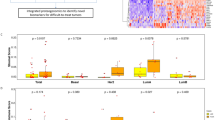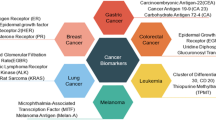Abstract
Recurrence or metastasis of colorectal cancer (CRC) is common following surgery and/or adjuvant therapy, particularly in patients with an advanced stage of the cancer. Identifying key molecular markers of CRC is beneficial for early diagnosis and early treatment, which may eventually improve the prognosis of patients with CRC. Isobaric mass tags for relative and absolute quantification (iTRAQ) in combination with multidimensional liquid chromatography and tandem mass spectrometry (LC-MS/MS) were used to identify differentially expressed proteins between CRC tissues and paired adjacent normal mucosa. Among the 105 patients, adenocarcinoma was the most common CRC subtype, stage III was the most common Tumor-Node-Metastasis stage and high levels of Ki-67 indicated the rapid proliferation of tumor cells in the samples. The LC-MS/MS-based iTRAQ technology identified 271 differentially expressed proteins, with 130 upregulated proteins and 141 downregulated proteins. Bioinformatics analysis revealed that golgin subfamily A member 2 (GOLGA2) and heterogeneous nuclear ribonucleoprotein D0 (hnRNPD) were located in the center of the upregulated protein network, and were closely associated with the development of CRC. The upregulation of GOLGA2 and hnRNPD was further verified in human tissues using western blotting and immunohistochemistry. GOLGA2 and hnRNPD were identified as two novels differentially expressed proteins in human CRC. Furthermore, the LC-MS/MS-based iTRAQ proteomic approach is a useful tool for searching and identifying differentially expressed proteins, and may be used to provide a comprehensive understanding of the processes that mediate the development of CRC.





Similar content being viewed by others
References
Ferlay J, Soerjomataram I, Dikshit R, Eser S, Mathers C, Rebelo M, Parkin DM, Forman D, Bray F (2015) Cancer incidence and mortality worldwide: sources, methods and major patterns in GLOBOCAN 2012. Int J Cancer 136(5):E359–E386
Karanikas M, Esebidis A (2016) Increasing incidence of colon cancer in patients <50 years old: a new entity? Ann Transl Med 4(9):164
Torre LA, Bray F, Siegel RL, Ferlay J, Lortet-Tieulent J, Jemal A (2015) Global cancer statistics, 2012. CA Cancer J Clin 65(2):87–108
Barton MK (2012) Oxaliplatin in the adjuvant treatment of colon cancer. CA Cancer J Clin 62(1):3–4
Lote H, Spiteri I, Ermini L, Vatsiou A, Roy A, McDonald A, Maka N, Balsitis M, Bose N, Simbolo M, Mafficini A, Lampis A, Hahne JC, Trevisani F, Eltahir Z, Mentrasti G, Findlay C, Kalkman EAJ, Punta M, Werner B, Lise S, Aktipis A, Maley C, Greaves M, Braconi C, White J, Fassan M, Scarpa A, Sottoriva A, Valeri N (2017) Carbon dating cancer: defining the chronology of metastatic progression in colorectal cancer. Ann Oncol 28:1243–1249
Chaffer CL, Weinberg RA (2011) A perspective on cancer cell metastasis. Science 331(6024):1559–1564
Tao Y, Han T, Zhang T, Sun C (2017) Sulfatase-2 promotes the growth and metastasis of colorectal cancer by activating Akt and Erk1/2 pathways. Biomed Pharmacother 89:1370–1377
Shen T, Yang Z, Cheng X, Xiao Y, Yu K, Cai X, Xia C, Li Y (2017) CXCL8 induces epithelial-mesenchymal transition in colon cancer cells via the PI3K/Akt/NF-kappaB signaling pathway. Oncol Rep 37:2095–2100
Huang GL et al (2017) Oncogenic retinoic acid receptor gamma knockdown reverses multi-drug resistance of human colorectal cancer via Wnt/beta-catenin pathway. Cell Cycle:1–8
Wang Z et al (2017) Endothelin promotes colorectal tumorigenesis by activating YAP/TAZ. Cancer Res 77(9):2413–2423
Chen CL, Chung T, Wu CC, Ng KF, Yu JS, Tsai CH, Chang YS, Liang Y, Tsui KH, Chen YT (2015) Comparative tissue proteomics of microdissected specimens reveals novel candidate biomarkers of bladder Cancer. Mol Cell Proteomics 14(9):2466–2478
Bouchal P, Roumeliotis T, Hrstka R, Nenutil R, Vojtesek B, Garbis SD (2009) Biomarker discovery in low-grade breast cancer using isobaric stable isotope tags and two-dimensional liquid chromatography-tandem mass spectrometry (iTRAQ-2DLC-MS/MS) based quantitative proteomic analysis. J Proteome Res 8(1):362–373
Chen RX, Song HY, Dong YY, Hu C, Zheng QD, Xue TC, Liu XH, Zhang Y, Chen J, Ren ZG, Liu YK, Cui JF (2014) Dynamic expression patterns of differential proteins during early invasion of hepatocellular carcinoma. PLoS One 9(3):e88543
Li Y, Wang X, Ao MH, Gabrielson E, Askin F, Zhang H, Li QK (2013) Aberrant Mucin5B expression in lung adenocarcinomas detected by iTRAQ labeling quantitative proteomics and immunohistochemistry. Clin Proteomics 10(1):15
Sun CY, Xia GW, Xu K, Ding Q (2010) Application of iTRAQ in proteomic study of prostate cancer. Zhonghua Nan Ke Xue 16(8):741–744
Ashburner M, Ball CA, Blake JA, Botstein D, Butler H, Cherry JM, Davis AP, Dolinski K, Dwight SS, Eppig JT, Harris MA, Hill DP, Issel-Tarver L, Kasarskis A, Lewis S, Matese JC, Richardson JE, Ringwald M, Rubin GM, Sherlock G (2000) Gene ontology: tool for the unification of biology. The gene ontology consortium. Nat Genet 25(1):25–29
Zhang B, Kirov S, Snoddy J (2005) WebGestalt: an integrated system for exploring gene sets in various biological contexts. Nucleic Acids Res 33(Web Server issue):W741–W748
da Huang W, Sherman BT, Lempicki RA (2009) Systematic and integrative analysis of large gene lists using DAVID bioinformatics resources. Nat Protoc 4(1):44–57
Kanehisa M, Furumichi M, Tanabe M, Sato Y, Morishima K (2017) KEGG: new perspectives on genomes, pathways, diseases and drugs. Nucleic Acids Res 45(D1):D353–D361
Kanehisa M, Sato Y, Kawashima M, Furumichi M, Tanabe M (2016) KEGG as a reference resource for gene and protein annotation. Nucleic Acids Res 44(D1):D457–D462
Orchard S, Ammari M, Aranda B, Breuza L, Briganti L, Broackes-Carter F, Campbell NH, Chavali G, Chen C, del-Toro N, Duesbury M, Dumousseau M, Galeota E, Hinz U, Iannuccelli M, Jagannathan S, Jimenez R, Khadake J, Lagreid A, Licata L, Lovering RC, Meldal B, Melidoni AN, Milagros M, Peluso D, Perfetto L, Porras P, Raghunath A, Ricard-Blum S, Roechert B, Stutz A, Tognolli M, van Roey K, Cesareni G, Hermjakob H (2014) The MIntAct project--IntAct as a common curation platform for 11 molecular interaction databases. Nucleic Acids Res 42(Database issue):D358–D363
Shannon P, Markiel A, Ozier O, Baliga NS, Wang JT, Ramage D, Amin N, Schwikowski B, Ideker T (2003) Cytoscape: a software environment for integrated models of biomolecular interaction networks. Genome Res 13(11):2498–2504
Dai P, Wang Q, Wang W, Jing R, Wang W, Wang F, Azadzoi K, Yang JH, Yan Z (2016) Unraveling molecular differences of gastric Cancer by label-free quantitative proteomics analysis. Int J Mol Sci 17(1)
Witkos TM, Lowe M (2017) Recognition and tethering of transport vesicles at the Golgi apparatus. Curr Opin Cell Biol 47:16–23
Potelle S, Klein A, Foulquier F (2015) Golgi post-translational modifications and associated diseases. J Inherit Metab Dis 38(4):741–751
Chang SH, Hong SH, Jiang HL, Minai-Tehrani A, Yu KN, Lee JH, Kim JE, Shin JY, Kang B, Park S, Han K, Chae C, Cho MH (2012) GOLGA2/GM130, cis-Golgi matrix protein, is a novel target of anticancer gene therapy. Mol Ther 20(11):2052–2063
Nakamura N (2010) Emerging new roles of GM130, a cis-Golgi matrix protein, in higher order cell functions. J Pharmacol Sci 112(3):255–264
Medici D, Hay ED, Olsen BR (2008) Snail and slug promote epithelial-mesenchymal transition through beta-catenin-T-cell factor-4-dependent expression of transforming growth factor-beta3. Mol Biol Cell 19(11):4875–4887
Tse JC, Kalluri R (2007) Mechanisms of metastasis: epithelial-to-mesenchymal transition and contribution of tumor microenvironment. J Cell Biochem 101(4):816–829
Kalluri R, Weinberg RA (2009) The basics of epithelial-mesenchymal transition. J Clin Invest 119(6):1420–1428
Godde NJ, Galea RC, Elsum IA, Humbert PO (2010) Cell polarity in motion: redefining mammary tissue organization through EMT and cell polarity transitions. J Mammary Gland Biol Neoplasia 15(2):149–168
Lee SC, Kim OH, Lee SK, Kim SJ (2015) IWR-1 inhibits epithelial-mesenchymal transition of colorectal cancer cells through suppressing Wnt/beta-catenin signaling as well as survivin expression. Oncotarget 6(29):27146–27159
Nieto MA (2013) Epithelial plasticity: a common theme in embryonic and cancer cells. Science 342(6159):1234850
Roy E, Bruyère J, Flamant P, Bigou S, Ausseil J, Vitry S, Heard JM (2012) GM130 gain-of-function induces cell pathology in a model of lysosomal storage disease. Hum Mol Genet 21(7):1481–1495
Zhao J, Yang C, Guo S, Wu Y (2015) GM130 regulates epithelial-to-mesenchymal transition and invasion of gastric cancer cells via snail. Int J Clin Exp Pathol 8(9):10784–10791
Han N, Li W, Zhang M (2013) The function of the RNA-binding protein hnRNP in cancer metastasis. J Cancer Res Ther 9(Suppl):S129–S134
Gouble A, Grazide S, Meggetto F, Mercier P, Delsol G, Morello D (2002) A new player in oncogenesis: AUF1/hnRNPD overexpression leads to tumorigenesis in transgenic mice. Cancer Res 62(5):1489–1495
Geng Y, Zhang L, Xu M, Sheng W, Dong A, Cao J, Cao J (2015) The expression and significance of hnRNPD in esophageal squamous cell carcinoma cells. Xi Bao Yu Fen Zi Mian Yi Xue Za Zhi 31(12):1659–1663
Kumar M, Matta A, Masui O, Srivastava G, Kaur J, Thakar A, Shukla NK, RoyChoudhury A, Sharma M, Walfish PG, Michael Siu KW, Chauhan SS, Ralhan R (2015) Nuclear heterogeneous nuclear ribonucleoprotein D is associated with poor prognosis and interactome analysis reveals its novel binding partners in oral cancer. J Transl Med 13:285
Trojanowicz B, Brodauf L, Sekulla C, Lorenz K, Finke R, Dralle H, Hoang-Vu C (2009) The role of AUF1 in thyroid carcinoma progression. Endocr Relat Cancer 16(3):857–871
Eder S, Arndt A, Lamkowski A, Daskalaki W, Rump A, Priller M, Genze F, Wardelmann E, Port M, Steinestel K (2017) Baseline MAPK signaling activity confers intrinsic radioresistance to KRAS-mutant colorectal carcinoma cells by rapid upregulation of heterogeneous nuclear ribonucleoprotein K (hnRNP K). Cancer Lett 385:160–167
Zhang Z, Zhou C, Chang Y, Zhang Z, Hu Y, Zhang F, Lu Y, Zheng L, Zhang W, Li X, Li X (2016) Long non-coding RNA CASC11 interacts with hnRNP-K and activates the WNT/beta-catenin pathway to promote growth and metastasis in colorectal cancer. Cancer Lett 376(1):62–73
Funding
The present study was supported by the National Natural Science Foundation of China (grant no.81273745), the Tianjin Natural Science Foundation (grant no.11JCYBJC10900), Sub Project of Key Projects in Tianjin (grant no.15ZXLCSY00040-08) and Science and Technology Program of Tianjin, China (grant no.16ZXHLSY00120).
Author information
Authors and Affiliations
Corresponding author
Ethics declarations
Competing Interests
The authors declare that they have no competing interests.
Additional information
Publisher’s Note
Springer Nature remains neutral with regard to jurisdictional claims in published maps and institutional affiliations.
Rights and permissions
About this article
Cite this article
Bai, Y., Wang, J., Gao, Z. et al. Identification and Verification of Two Novel Differentially Expressed Proteins from Non-neoplastic Mucosa and Colorectal Carcinoma Via iTRAQ Combined with Liquid Chromatography-Mass Spectrometry. Pathol. Oncol. Res. 26, 967–976 (2020). https://doi.org/10.1007/s12253-019-00651-y
Received:
Accepted:
Published:
Issue Date:
DOI: https://doi.org/10.1007/s12253-019-00651-y




